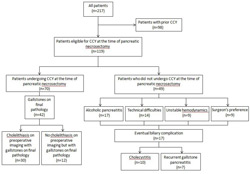|
Back to 2014 Annual Meeting Abstracts
Single-Stage Cholecystectomy At the Time of Pancreatic Necrosectomy Is Safe and Prevents Future Biliary Complications: a 20-Year Single Institutional Experience With 217 Consecutive Patients
Zhi Ven Fong*, Miroslav P. Peev, Andrew L. Warshaw, Keith D. Lillemoe, Carlos Fernandez-Del Castillo, George C. Velmahos, Peter J. Fagenholz
General Surgery, Massachusetts General Hospital, Boston, MA
Introduction: Current guidelines recommend cholecystectomy (CCY) during the index admission for mild to moderate biliary pancreatitis as delayed CCY is associated with a substantial risk of recurrent biliary events. Delayed CCY is recommended in severe pancreatitis. As a result, CCY is frequently avoided at the time of pancreatic necrosectomy, although no studies have investigated the related outcomes. We sought to determine the safety of single-stage CCY performed at the time of necrosectomy and its effectiveness in preventing subsequent biliary complications.
Methods: We retrospectively queried our institutional database of patients who underwent pancreatic necrosectomy for necrotizing pancreatitis from 1992-2012.
Results: We identified 217 consecutive patients who underwent pancreatic necrosectomy during the study period. The most common etiologies of pancreatitis were biliary (41%) and alcoholic (24%), with a median CT-severity index score of 6±1.6 and a 63.6% incidence of infected necrosis. Of them, 70 (59%) patients with a gallbladder underwent CCY at the time of pancreatic necrosectomy. CCY was not performed in the remaining 41% due to a clear non-biliary etiology (35%), technical difficulty (29%), intraoperative hemodynamic instability (18%), or surgeon preference (18%). There was 1 complication (gallbladder fossa hemorrhage) related to the single stage CCY at a median follow-up of 32 months. Based on final histopatholgical analysis, 43% of patients who had no cholelithiasis or biliary sludge on preoperative imaging had gallstones or sludge identified pathologically after single stage CCY. Of those who did not receive a single stage CCY, biliary complications developed in 35% of patients (21% cholecystitis, 14% recurrent gallstone pancreatitis) at a median time to incidence of 10 months. Seventeen (12%) patients eventually received a post-necrosectomy cholecystectomy, of which 75% required an open procedure.
Conclusion: This is the first study demonstrating that single stage CCY at the time of pancreatic necrosectomy is safe in selected patients and should be performed if technically feasible to prevent future biliary complications and reduce the need for a subsequent separate, often open, abdominal operation.

Denominator diagram of patients who underwent single-stage cholecystectomy at the time of pancreatic necrosectomy and those that did not.
Back to 2014 Annual Meeting Abstracts
|


